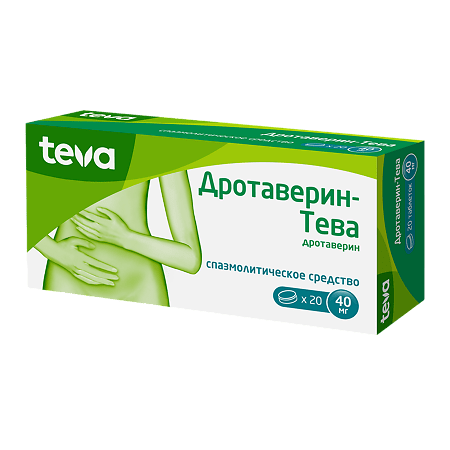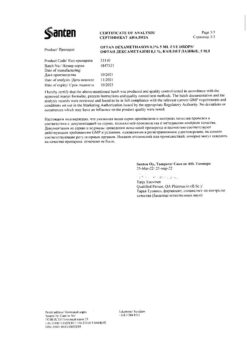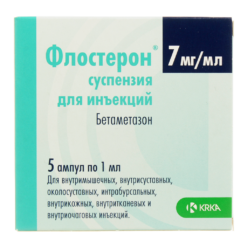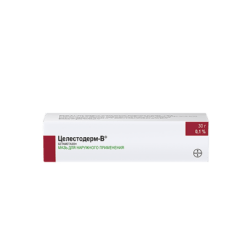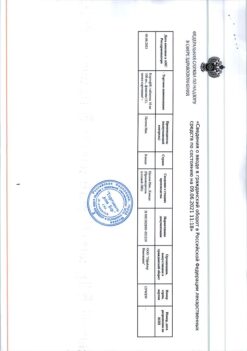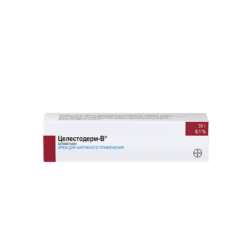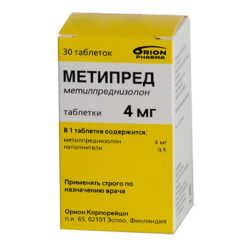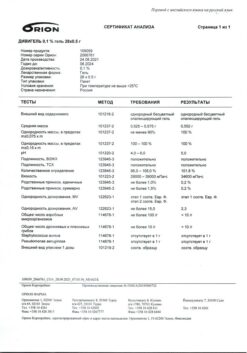Subtotal: €7.33
Drotaverin-Teva, tablets 40 mg 20 pcs
€2.00
Pharmacological group: spasmolytic agent
ATX code: A03AD02
Pharmacological properties
Pharmacodynamics
Drotaverine is an isoquinoline derivative that has an antispasmodic effect on smooth muscle by inhibiting the enzyme phosphodiesterase 4 (PDE-4). Inhibition of FDE-4 leads to increased concentrations of cyclic adenosine monophosphate (cAMP), which inactivates myosin light chain kinase (MLCK), which, in turn, leads to relaxation of smooth muscles.
Drotaverine inhibits the enzyme FDE-4 in vitro without inhibiting the FDE-3 and FDE-5 isoenzymes. FDE-4 appears to be functionally very important in reducing smooth muscle contractility, so selective FDE-4 inhibitors may be effective in the treatment of hyperkinetic diseases and diseases associated with gastrointestinal (GI) spasticity.
The enzyme that hydrolyzes zAMP in myocardial and vascular smooth muscle cells is primarily an FDE-3 isoenzyme, which explains the high efficacy of drotaverine as an antispasmodic with no pronounced cardiovascular effects or serious cardiovascular adverse reactions.
Drotaverine is effective for smooth muscle spasms of both nervous and muscular etiology. Regardless of the type of autonomic innervation, drotaverine acts on the smooth muscles of the gastrointestinal tract, biliary tract, as well as the urogenital and vascular systems. Due to its vasodilator effect, drotaverine improves blood supply to tissues.
Pharmacokinetics
absorption and distribution<
In oral and parenteral administration, drotaverine is rapidly and completely absorbed.
The maximum plasma concentration (Cmax) is reached within 45-60 minutes. It binds to plasma proteins (alpha-albumin, alpha- and beta-globulin).
Metabolism and excretion
Metabolized in the liver. The half-life (T1/2) is 16-22 hours.
Drotaverine is eliminated from the body after 72 hours mainly as metabolites, 50% – by the kidneys, 30% – through the intestine.
Indications
Spasms of smooth muscles associated with diseases of the liver and biliary tract: cholelithiasis, cholecystitis, pericholecystitis, cholangitis, papillitis;
spasms of smooth muscles of the urinary system: urolithiasis, pyelitis, cystitis, bladder tenesmus.
As an adjuvant therapy:
spasms of smooth muscles of the gastrointestinal tract: peptic ulcer of the stomach and duodenum, gastritis, spasms of the cardia and pylorus, enteritis, colitis, accompanied by constipation and flatulence;
tensor headache;
dysmenorrhea.
Pharmacological effect
Pharmacological group: antispasmodic
ATX code: A03AD02
Pharmacological properties
Pharmacodynamics
Drotaverine is an isoquinoline derivative that exhibits an antispasmodic effect on smooth muscle by inhibiting the enzyme phosphodiesterase 4 (PDE-4). Inhibition of the PDE4 enzyme results in increased concentrations of cyclic adenosine monophosphate (cAMP), which inactivates myosin light chain kinase (MLCK), which in turn leads to smooth muscle relaxation.
Drotaverine inhibits the PDE-4 enzyme in vitro without inhibiting the PDE-3 and PDE-5 isoenzymes. PDE-4 appears to be functionally very important in reducing smooth muscle contractility, so selective PDE-4 inhibitors may be effective in the treatment of hyperkinetic diseases and diseases associated with spastic conditions of the gastrointestinal tract (GIT).
The enzyme that hydrolyzes cAMP in the smooth muscle cells of the myocardium and blood vessels is mainly an isoenzyme of PDE-3, which explains the high effectiveness of drotaverine as an antispasmodic in the absence of a pronounced effect on the cardiovascular system and serious cardiovascular adverse reactions.
Drotaverine is effective for spasms of smooth muscles of both nervous and muscular etiology. Regardless of the type of autonomic innervation, drotaverine acts on the smooth muscles of the gastrointestinal tract, biliary tract, as well as the genitourinary and vascular systems. Thanks to its vasodilating effect, drotaverine improves blood supply to tissues.
Pharmacokinetics
Suction and distribution
When taken orally and parenterally, drotaverine is quickly and completely absorbed.
Maximum plasma concentration (Cmax) is achieved within 45-60 minutes. Binds to plasma proteins (alpha albumin, alpha and beta globulins).
Metabolism and excretion
Metabolized in the liver. The half-life (T1/2) is 16-22 hours.
After 72 hours, drotaverine is excreted from the body mainly in the form of metabolites, 50% by the kidneys, 30% through the intestines.
Special instructions
When using the drug Drotaverin-Teva in patients with arterial hypotension, caution should be exercised.
The tablets contain lactose, so Drotaverin-Teva is not prescribed to patients with lactose intolerance, lactase deficiency, or glucose-galactose malabsorption syndrome.
Impact on the ability to drive vehicles and machinery
When taken orally in therapeutic doses, drotaverine does not affect the ability to drive vehicles or perform work that requires increased concentration.
If any adverse reactions occur, the issue of driving and operating machinery requires individual consideration. If dizziness occurs after taking the drug, the patient should avoid engaging in potentially hazardous activities, such as driving vehicles and operating machinery.
Active ingredient
Drotaverine
Composition
1 tablet contains:
active substance:
drotaverine hydrochloride 40.00 mg;
excipients:
lactose monohydrate 67.00 mg;
povidone-K25 4.00 mg;
microcrystalline cellulose 21.00 mg;
croscarmellose sodium 5.00 mg;
magnesium stearate 3.00 mg.
Pregnancy
Drotaverine does not have teratogenic or embryotoxic effects. However, the use of the drug Drotaverin-Teva is recommended only after carefully weighing the ratio of the expected benefits and possible risks.
Due to the lack of necessary clinical data, Drotaverin-Teva is not recommended for use during breastfeeding.
Contraindications
Hypersensitivity to drotaverine or to any of the components of the drug; severe renal failure; severe liver failure (class C on the Child-Pugh scale); severe heart failure (low cardiac output syndrome); children under 6 years of age; breastfeeding period; lactose intolerance, lactase deficiency, glucose-galactose malabsorption syndrome.
With caution
Pregnancy, arterial hypotension, simultaneous use with levodopa.
Side Effects
Side effects are classified according to the following frequency: very often – at least 10%; often – at least 1%, but less than 10%; infrequently – not less than 0.1%, but less than 1%; rarely – not less than 0.01%, but less than 0.1%; very rarely (including individual reports) – less than 0.01%; frequency unknown – insufficient data to estimate the frequency of the phenomenon in the population.
From the gastrointestinal tract: rarely – nausea, constipation.
From the central nervous system: rarely – headache, dizziness, insomnia.
From the cardiovascular system: rarely – rapid heartbeat; very rarely – decreased blood pressure.
Interaction
With levodopa
When used simultaneously, it may weaken the antiparkinsonian effect of levodopa, that is, increase rigidity and tremor.
With papaverine, bendazole and other antispasmodics (including M-anticholinergics)
Strengthening the antispasmodic effect.
With morphine
Reducing the spasmogenic activity of morphine.
With phenobarbital
Strengthening the antispasmodic effect of drotaverine.
Overdose
There is no data on an overdose of Drotaverin-Teva.
Symptoms of overdose may include cardiac arrhythmias and conduction disorders (including complete block of the bundle branches), cardiac arrest, and even death.
Treatment: gastric lavage, symptomatic therapy.
Storage conditions
In a dry place, protected from light, at a temperature not exceeding 25 °C.
Shelf life
3 years.
Manufacturer
Adifarm EAD, Bulgaria
| Shelf life | 3 years. |
|---|---|
| Conditions of storage | In a dry, light-protected place at a temperature not exceeding 25 °C. |
| Manufacturer | Adipharm EAD, Bulgaria |
| Medication form | pills |
| Brand | Adipharm EAD |
Related products
Buy Drotaverin-Teva, tablets 40 mg 20 pcs with delivery to USA, UK, Europe and over 120 other countries.


